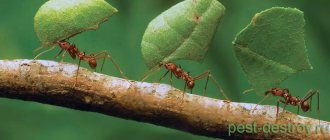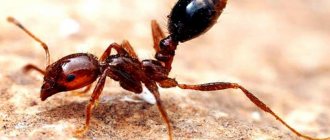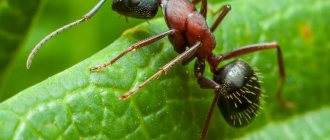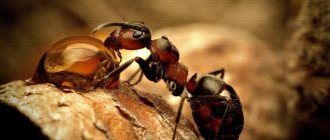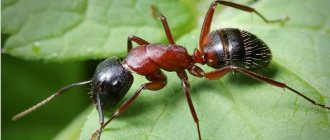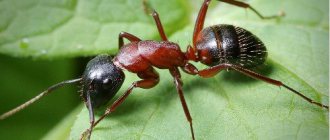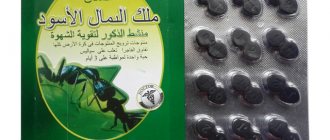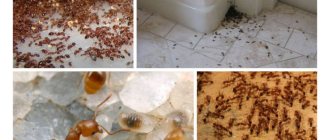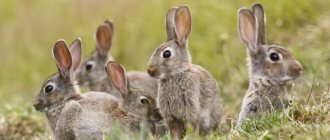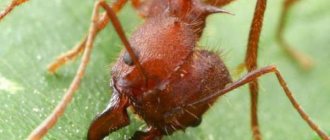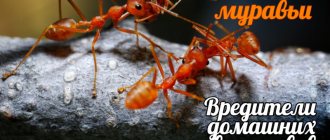Features of the view
Insects have different body colors - black, brown, reddish. Body length from 4 to 9 mm maximum. Females are several times larger than males. Working individuals differ somewhat in structure. In the anthill there is a clear division into castes, with a large number of “professions”. Nannies, midwives, transporters, guards, warriors, food providers, warehouse keepers and so on.
Places where harvester ants live have arid climates - Asia, Africa, America, Southern Europe. Residents of desert, semi-desert regions. The steppe harvester ant builds colonies of 500 to 50,000 individuals. It prefers to live near fields with cereal crops. It goes in search of food 80 m from the anthill.
Anthill structure
The “houses” of these insects are complex and have a surprisingly well-thought-out structure. More than a million individuals can be in it at the same time. The anthill has several exits, each of which is guarded by “soldiers,” as well as a large number of “production” premises.
- There is a “cow barn” - a chamber for keeping aphids (insects that ants breed and protect).
- Cemetery - a compartment for dead insects and various garbage.
- Barns are places for storing supplies. Moreover, there are several types of barns: for “grain” (plant seeds collected by the reapers are stored here) and for “meat”, where caterpillars, flies or other insects brought are stored.
- Place for the uterus. The queen of the colony lives in her own room, her main task is laying eggs. She is cared for by special working individuals.
- Finally, there are chambers with offspring, where larvae, pupae, eggs and workers monitoring them are located.
Indeed, the structure of the insect colony’s home is striking in its logic.
- Messor aciculatus;
- Messor denticulatus;
- Messor kasakorum;
- Messor rufitarsis;
- Messor constructor.
The genus received the name Messor (reaper) due to the method of collecting grain from the fields. The specificity of nutrition is determined by the nature of vegetation in the desert climate. According to research, ants from one family are able to bring up to 1.5 kg of grain to underground storage facilities. The answer to the question: is the harvester ant a pest that steals the fruits of human labor should be answered in the negative. He harvests his harvest only from the ground, from already damaged spikelets. The grains are stored in moist underground chambers for a long time and periodically germinate. Then the ants chew off the seedlings, and the seeds themselves are ground into powder, moistened with saliva and fed to the larvae.
Reaper ants have their own characteristics:
- large size of individuals;
- peacefulness;
- swarming, nest building in spring.
Let us consider this genus in more detail using the example of the species Messor structor (steppe harvester ant).
Foraging for food
For a long time it was believed that messor constructor ants were agricultural pests, since large reserves of wheat, barley, millet, and millet grains were found in their anthills. Later, it became known what ants eat and how they collect seeds.
Reaper ants The peculiarity is that reaper ants collect grains from the ground without touching the growing ear. They pick up the “harvest” after the activity of harmful turtles, mice and other pests.
Interesting!
Numerous chambers for storing grain are built in the anthill. In one season they can collect up to 50 kg of grains. An insect can eat all this in one season. In tropical countries, abundant ant stocks are often the subject of controversy. Who owns the found grain - the owners of the field where the anthill is located, or the owner of the land from where the reapers carried the harvest.
A family of ants sends different numbers of messengers in search of food. How many are required depends on the speed at which the sent family members return. If there is a lot of harvest, the ants return quickly and bring large supplies.
In distress, the ant is absent from the fields for a long time; after its return, fewer individuals are sent to the fields. Gradually reducing the number to zero.
Where do ants live
These insects are distributed almost all over the world; they are not found only in areas covered with eternal glaciers and in ocean spaces. They learned to amazingly adapt to the most difficult living conditions, even deserts and cold northern regions were no exception.
To build an anthill you can use:
- tree;
- a cavity in the ground;
- human dwelling.
Sometimes hardworking insects build their own homes. Where ants live depends on their species. For example, blacks prefer to build their homes in the ground or in rotten wood. Redheads make anthills under stones or tree trunks torn out by the wind. Forest people build impressive “mansions” in size, which can be more than 2 meters in height. Pharaohs prefer a humid climate and the proximity of human habitation, so they often become inhabitants of ventilation ducts, spaces behind the baseboards, and even furniture. Individual colonies take over other people's homes.
Nutritional Features
Unlike other species, harvester ants feed exclusively on plant foods. Even the larvae are fed grain, while representatives of other species require the juices of other insects.
Inventories are monitored very carefully. When grains sprout, starch turns into sugar, which is of particular value to the ant family. The workers quickly nibble off the roots and sprouts, and carefully sort through the supplies. The larvae are fed with ground flour.
Reproduction
Reproduction of ants Young females and males grow wings during the mating period. Flying ants spend the mating season in the air. The males soon die, the females go deeper into the ground and lay eggs. From them, working individuals are born, which are taken to arranging a new anthill.
Interesting!
One fertilization is enough for the uterus to reproduce offspring for a lifetime. How long harvester ants live depends on the caste to which they belong. The queen can live 28 years, individuals working in an anthill - 5 years, working ants - a maximum of 3 years.
Maintenance and care at home
Beginners who want to have an ant farm in their apartment are advised to get steppe reapers. They are non-aggressive, unpretentious in food, and it is not difficult to create acceptable living conditions for them. Having provided them with enough water and food, you can safely leave them unattended for a while, for example, for a vacation.
Under favorable climatic conditions, Messor structor ants do not hibernate. Therefore, you can observe their life activities even in the cold season.
Start of the colony
Any family of ants begins with a fertilized queen, Messor structor are no exception. There are two ways to get a future queen:
- Buy it in a specialized online store. Typically, the queen is sold with several worker ants and brood. They arrive already in the incubator.
- Catch it yourself. This can be done during the summer. In this case, ant breeding begins by placing the queen in an incubator.
You should not buy the queen from strangers. There is a risk of getting an unfertilized or sick individual.
Incubator
A standard incubator for harvester ants is made from a medical test tube. Fill the container one-third full with filtered water and insert a piece of cotton wool inside, making sure that it does not leak anywhere. After this, the uterus is placed in the test tube. The hole is closed with another cotton swab.
The incubator is placed in a dark place and the offspring are expected to appear. When the number of insects increases, it is connected to the arena.
Formicarium
So that harvester ants can develop their colony, store supplies, and raise offspring, an artificial nest is created for Messor structor. Currently, quite a lot of formicaria are sold, differing in configuration, size and fillers. Sometimes they are made independently, but the work requires certain skills and knowledge. The humidity gradient must also be taken into account. This is necessary so that the reapers can store grain in dry chambers and germinate it in wetter ones.
Arena
The arena is a necessary element of the ant farm. Food is laid out on it, a drinking bowl is placed, and decorations can be placed. Insects will also carry seeds here to dry.
Ant farm
The arena must be systematically cleaned, as the reapers produce a lot of garbage.
Escape protection
To prevent the ants from running away, the edges of the arena are lubricated with a special “Anti-Escape” product or Vaseline. This will keep the lid open.
Larval development
Individuals take care of the eggs, move them to separate chambers, and ensure that favorable conditions are maintained. Division into castes occurs already during the hatching of the larvae. Which of them will be who in society depends on the amount of food consumed.
The larvae are not able to move or eat independently. All this is provided by breadwinners and caregivers. The young are constantly increasing in size and pupate after 1-2 months. The pupa does not have a dense shell; the development of insects can be monitored. At the last stage, it begins to move and a full-fledged insect appears.
Habitat
The steppe harvester ant is a resident of the steppes and deserts. Its nests can be found in the countries of the Mediterranean coast, Southern and Eastern Europe, the Caucasus, Middle and Central Asia, Afghanistan, Iran, Iraq, Lebanon, Syria, and Israel. On the territory of Russia, in the Republic of Tatarstan, the species is included in the Red Book due to the threat of extinction.
Years
Reapers are ants of deserts and steppes. Such a life developed an interesting feature in them. Almost all species of ants we encounter raise young males and females in the spring, so that by the end of spring or summer they can fly away and give rise to new colonies. The Messors have a completely different strategy: young individuals capable of reproducing are raised not in May, but in August. Next, the winged generation overwinters in its native anthill and flies out by the end of April. At a time when the queens of other ants are still in the larval state, messoras are already beginning to raise the first generation of new workers. It would seem, why such oddities? The answer is simple: in steppes and semi-deserts, the most favorable conditions for the creation of new colonies appear in the spring, when the average daily temperature is not so high and soil moisture remains.
